Need some fresh new note taking methods to help you brush up your study skills or share with your students? We’ve got you covered.
If you are a student, a researcher, or just someone like me who loves to learn, you might be feeling like your brain is at max capacity with the new information you are trying to remember each day. Do you ever wonder how our brains decide what information is important enough to hang on to and what can be discarded? Why is it that I can’t recall what I had for breakfast yesterday, but I can still remember my high school biology teacher describing “osmosis” as the diffusion of water molecules through a semipermeable membrane?
Studying what we learn is vital to remembering what we’ve learned.
I learned something fascinating today about how our brains remember (…and forget) information. In the late 1800’s, a German psychologist and philosopher named Herman Ebbinghaus studied how we retain memories. His groundbreaking work was depicted by what he coined the Ebbinghaus Forgetting Curve. This was a graph displaying the rate our memory retention deteriorates over a period of time. His research showed that a student who reviews what they’ve learned over a 30-day period has a 70% retention rate. In contrast, a student who does not review or study the material has only a 15% retention rate after 30 days. When it comes to learning new information, research has shown that 24 hours after class, you will remember less than half of what you remembered at the very end of class.
What does this all mean? Well first off, I guess I should have taken advantage of study hall in school for more than just napping and passing notes. Ebbinghaus confirmed that studying what we learn is vital to remembering what we’ve learned. If we want to be successful students, we need to develop great study habits. Getting organized with some solid note taking methods can help make studying more efficient. It will also help us retain what we are learning right from the start, before that 24-hour window of drastic memory decline sets in. Let’s explore some popular note taking methods that will put you back on top of the Forgetting Curve.
Cornell Notes
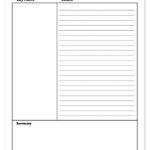

This tried-and-true method of note taking has been around since the 1950’s and is a favorite for many college professors. Here’s how it works:
1: Divide your notebook paper into 3 sections.
- Cue Section: Create a 2.5-inch margin on the left.
- Summary Section: Draw a 2-inch footer at the bottom of your page.
- Notes Section: This is the remaining 6×9 inch section on the right.
2: During class, jot down as many notes as possible in the main Notes Section.
- Include things like dates, important people or places, diagrams, keywords with definitions, and formulas.
3: Next, in the Cue Section. consolidate your notes into categories or concise points.
- This is where you would write a main idea or a key question about the topic of your notes.
4: In the Summary Section, explain your page of notes in 1-2 sentences.
5: When it is time to study, cover up the Notes Section so you can’t see it, and using just what you see in the Cue Section, try to recite the important details of what you included in the Notes Section.
Need a printable template to create your own Cornell Notes? Click here to download it.
Outline Notes
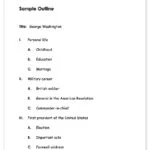

The outline note taking method is a classic, and if you’ve ever written a research paper, you probably already know this one well. An outline organizes information in a hierarchy using indentation. The more indented the content, the more detail it provides. Your generalized main points would be written on the left-most side of the page. Under each main topic, you would include any subtopics pertaining to that point and indent them. Each subtopic may have more details under it, further indented to the right. An outline can be easily formatted using programs like MS Word or Google Docs.
The sample outline pictured here from studenthandouts.com shows how you might format notes on the life of George Washington. For a blank template you can use to create your own outline notes, click here.
Mindmapping Notes
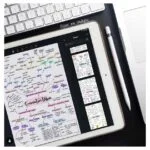

This free flowing, no-rules note taking method is ideal for creative minds who don’t like being boxed in by structure. This is similar to the standard brainstorming bubbles you may have learned in elementary school. Main ideas start in the center and then branch out into subtopics. Mindmapping will help you quickly organize information you are hearing. This is an ideal note taking method for abstract concepts or flushing out ideas.
The process is simple. Start by putting the topic or main point in the center. You then draw arrows or lines coming out from that main concept to direct to your subtopics. You can expand on each of those subtopics with drawings, additional details, or key facts. As you add information to any of these new ideas, you’ll continue to draw arrows or lines, elaborating on each one. You can then go back and connect associated ideas using more arrows and lines or by color coding with a highlighter.
Shown here is a beautiful example of the mind mapping note taking method in action from @just_me_studying on Instagram.
Split Page Notes
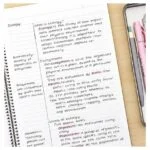

The Split Page technique is a simple note taking method, much like condensed flash cards on one page. Draw a line down the center of your page or fold your paper in half. On the left half, write the topic or keyword. Directly across from it, on the other half, write the details or definition to correspond with what you wrote on the left. This type of note taking can also be done digitally on a spreadsheet if you prefer to type your notes. Split Page notes are great for recording facts and will help with active recall.
(image source: Jet Pens
Sketchnotes
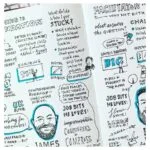

Sketchnotes, also called visual note taking, is a fun and creative way to organize new information you are learning. Using color, charts, illustrations, symbols, and doodles, students use sketchnotes to record information in picture format. This technique was developed by Mike Rohde, author of The Sketchnote Handbook and The Sketchnote Workbook. He provides encouragement and aims to make the note taking process fun. Rohde says his book is “designed to teach regular people, without any drawing skills, how to create sketchnotes. You’ll learn how to capture your thinking visually, remember key information more clearly, and share what you’ve learned with others.”
Rohde even offers a free mini workshop for getting started with visual note taking.
(image source: Mike Rohde)
Morse Code Method
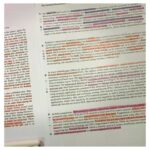

The Morse Code Method of note taking was developed by Carl Newport, a professor and the author of How to Become a Straight A Student. This technique is best used for annotating articles or textbooks rather than constructing new material. It is an efficient way to increase comprehension while not slowing down your reading momentum. To take notes as you read, put a dot next to each main idea and a dash next to each item that supports that main idea. After reading the article, you can summarize the main ideas into your own words by answering two questions:
- What is the main question being asked in this article?
- What is the conclusion the author is pointing towards?
(image source: https://www.bradford.ac.uk/)
Our favorite digital note taking tools
I’m a traditional notetaker, and I love a sturdy hardcover notebook with handful of highlighters and colored pens to keep me organized. If you prefer to trade in your pen and paper for a digital note taking tool, I’ve rounded up a list some of the favorites among my coworkers.
Evernote
This was a top choice among the staff at iteach. Evernote offers both a free and paid version depending on the features you need. This is way more than just a note taking app! It includes a place for an interactive task list that you can integrate with your calendar to remember important deadlines. It allows you to scan your handwritten notes to keep them organized and connected with your digital notes. You can even search for photos and handwritten text to quickly find what you need. Evernote allows you to sync all of your devices, making it easier to take notes whether you are in the classroom, at home, or on the go.
Rocketbook
If you still love your pen and paper but want some of the benefits a digital notetaking app offers, Rocketbook is a great choice. This is a heavy duty spiral bound notebook that works with a special set of erasable Pilot FriXion pens. You can take notes by hand and then quickly scan them to organize within the app or sync with email or file storage apps like Dropbox. The coolest part of Rocketbook is that once you fill up your notebook you can erase it completely with a microwave and a cup of water and start fresh. If you accidently erased a page of notes you needed, just pop it in the freezer for a few hours and bring it back to life. I have no idea how this magic works but it’s pretty fascinating!
Apple Notes
If you have an iphone, you have probably used Apple Notes. Apple Notes is extremely popular due to its accessibility. It is easy to use for jotting down quick notes and ideas and you can even include drawings. With Apple Notes, you can easily turn notes into a checklist. You can sync notes on multiple devices, scan documents to attach, and sort notes into folders. One feature that stood out to our staff and made this one a favorite was the ability to collaborate with others using shared notes.
Whink
Whink came up as a popular pick for ipad users. This app gives you the ability to take notes digitally with an apple pencil just as if you were writing on paper. You can even add voice recordings to capture a key point of a lecture and import images into your notes. Need to read or watch a video while taking notes? On the ipad, you have the flexibility to multitask by using Whink alongside another app.
Become a Teacher. Change Lives.
If you are passionate about impacting the world around you, there are few places where you can influence the future as much as a teacher. Teachers have the ability to build students up and set them on a positive course that can have a ripple effect on future generations.
If you are interested in becoming a teacher, check out our online teacher certification process, and you could be teaching in a matter of weeks.




